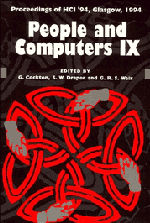Book contents
- Frontmatter
- Contents
- Preface: HCI'94 – You Probably Haven't Seen It All Before
- Part I Invited Papers
- Part II Methodology of Interactive Systems Development
- Crafting Interaction: Styles, Metaphors, Modalities and Agents
- Modelling Humans, Computers and their Interaction
- Notations and Tools for Design
- 22 XUAN: Enhancing UAN to Capture Temporal Relationships among Actions
- 23 Structured Notations to Support Human Factors Specification of Interactive Systems
- 24 Discount Dialogue Modelling with Action Simulator
- 25 Executable Task Analysis: Integration Issues
- 26 Beyond Data Models for Automated User Interface Generation
- Part VI Computer-Supported Cooperative Work
- Author Index
- Keyword Index
24 - Discount Dialogue Modelling with Action Simulator
Published online by Cambridge University Press: 04 August 2010
- Frontmatter
- Contents
- Preface: HCI'94 – You Probably Haven't Seen It All Before
- Part I Invited Papers
- Part II Methodology of Interactive Systems Development
- Crafting Interaction: Styles, Metaphors, Modalities and Agents
- Modelling Humans, Computers and their Interaction
- Notations and Tools for Design
- 22 XUAN: Enhancing UAN to Capture Temporal Relationships among Actions
- 23 Structured Notations to Support Human Factors Specification of Interactive Systems
- 24 Discount Dialogue Modelling with Action Simulator
- 25 Executable Task Analysis: Integration Issues
- 26 Beyond Data Models for Automated User Interface Generation
- Part VI Computer-Supported Cooperative Work
- Author Index
- Keyword Index
Summary
A description of the high level structure of a user interface is an important part of any system specification. Currently the most common way of thinking about and recording this part of the design is through story boards and verbal descriptions, these may be imprecise and are difficult to evaluate. Action Simulator allows a designer to build simple models of the high level behaviour of the user interface. The models are easy to read and can be executed to give a dynamic view of the design. This makes it possible to ‘run through’ the actions needed to complete the users' work. A procedure for characterising the users' work that is suitable for this purpose is also sketched out in the paper. Action Simulator consists of an Excel spreadsheet and associated macros and is publicly available.
Keywords: dialogue model, task model, work objective, decomposition, scenario, system behaviour, specification, spreadsheet.
The Need for Abstract Dialogue Models
The design of software, like any other undertaking in engineering, involves the construction of a specification that includes models of various kinds. The reason engineers construct a blue print or specification before building the artefact itself is that the latter is difficult to change and so between gathering requirements and implementation a specification is built that is easy to change. Analysis and evaluation of the specification enables improvements to be made before implementation begins. Also like other engineering projects, software is extremely complex and so difficult to reason about. For this reason engineers build models that concentrate on some aspect of the design and abstract across others.
- Type
- Chapter
- Information
- People and Computers , pp. 327 - 338Publisher: Cambridge University PressPrint publication year: 1994
- 7
- Cited by

